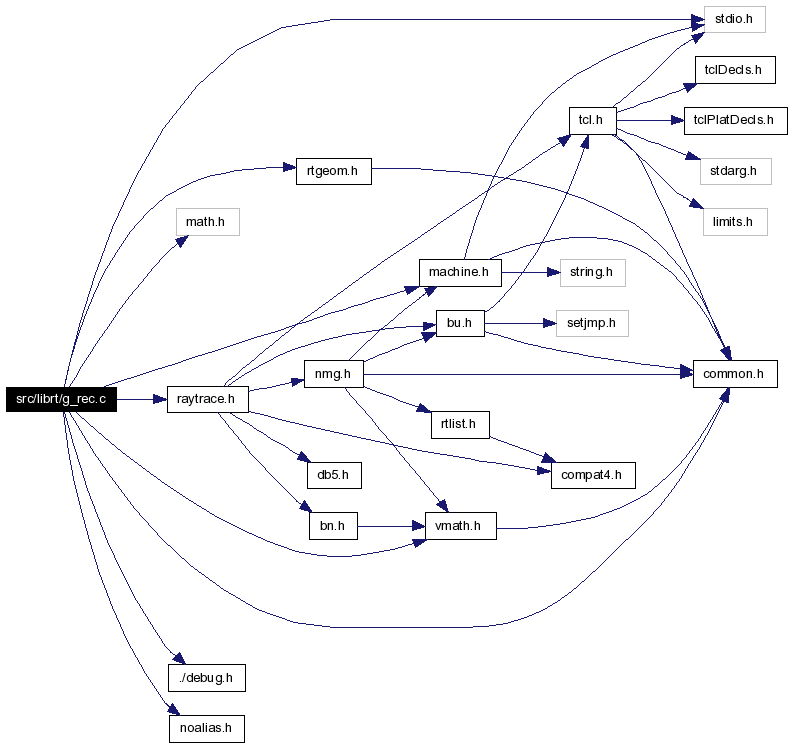
#include "common.h"#include <stdio.h>#include <math.h>#include "machine.h"#include "vmath.h"#include "raytrace.h"#include "rtgeom.h"#include "./debug.h"#include "noalias.h"Include dependency graph for g_rec.c:

Go to the source code of this file.
Data Structures | |
| struct | rec_specific |
Defines | |
| #define | REC_NORM_BODY (1) |
| #define | REC_NORM_TOP (2) |
| #define | REC_NORM_BOT (3) |
| #define | SEG_MISS(SEG) (SEG).seg_stp=(struct soltab *) 0; |
Functions | |
| int | rt_rec_prep (struct soltab *stp, struct rt_db_internal *ip, struct rt_i *rtip) |
| void | rt_rec_print (register const struct soltab *stp) |
| int | rt_rec_shot (struct soltab *stp, register struct xray *rp, struct application *ap, struct seg *seghead) |
| void | rt_rec_vshot (struct soltab **stp, struct xray **rp, struct seg *segp, int n, struct application *ap) |
| void | rt_rec_norm (register struct hit *hitp, struct soltab *stp, register struct xray *rp) |
| void | rt_rec_curve (register struct curvature *cvp, register struct hit *hitp, struct soltab *stp) |
| void | rt_rec_uv (struct application *ap, struct soltab *stp, register struct hit *hitp, register struct uvcoord *uvp) |
| void | rt_rec_free (struct soltab *stp) |
| int | rt_rec_class (void) |
Algorithm -
Given V, H, A, and B, there is a set of points on this cylinder
{ (x,y,z) | (x,y,z) is on cylinder }
Through a series of Affine Transformations, this set of points will be transformed into a set of points on a unit cylinder located at the origin with a radius of 1, and a height of +1 along the +Z axis.
{ (x',y',z') | (x',y',z') is on cylinder at origin }
The transformation from X to X' is accomplished by:
X' = S(R( X - V ))
where R(X) = ( A/(|A|) ) ( B/(|B|) ) . X ( H/(|H|) )
and S(X) = ( 1/|A| 0 0 ) ( 0 1/|B| 0 ) . X ( 0 0 1/|H| )
To find the intersection of a line with the surface of the cylinder, consider the parametric line L:
L : { P(n) | P + t(n) . D }
Call W the actual point of intersection between L and the cylinder. Let W' be the point of intersection between L' and the unit cylinder.
L' : { P'(n) | P' + t(n) . D' }
W = invR( invS( W' ) ) + V
Where W' = k D' + P'.
If Dx' and Dy' are both 0, then there is no hit on the cylinder; but the end plates need checking.
Line L' hits the infinitely tall unit cylinder at W' when
k**2 + b * k + c = 0
where
b = 2 * ( Dx' * Px' + Dy' * Py' ) / ( Dx'**2 + Dy'**2 ) c = ( ( Px'**2 + Py'**2 ) - r**2 ) / ( Dx'**2 + Dy'**2 ) r = 1.0
The qudratic formula yields k (which is constant):
k = [ -b +/- sqrt( b**2 - 4 * c ] / 2.0
Now, D' = S( R( D ) ) and P' = S( R( P - V ) )
Substituting,
W = V + invR( invS[ k *( S( R( D ) ) ) + S( R( P - V ) ) ] ) = V + invR( ( k * R( D ) ) + R( P - V ) ) = V + k * D + P - V = k * D + P
Note that ``k'' is constant, and is the same in the formulations for both W and W'.
The hit at ``k'' is a hit on the height=1 unit cylinder IFF 0 <= Wz' <= 1.
NORMALS. Given the point W on the surface of the cylinder, what is the vector normal to the tangent plane at that point?
Map W onto the unit cylinder, ie: W' = S( R( W - V ) ).
Plane on unit cylinder at W' has a normal vector N' of the same value as W' in x and y, with z set to zero, ie, (Wx', Wy', 0)
The plane transforms back to the tangent plane at W, and this new plane (on the original cylinder) has a normal vector of N, viz:
N = inverse[ transpose(invR o invS) ] ( N' ) = inverse[ transpose(invS) o transpose(invR) ] ( N' ) = inverse[ inverse(S) o R ] ( N' ) = invR o S ( N' )
Note that the normal vector produced above will not have unit length.
THE END PLATES.
If Dz' == 0, line L' is parallel to the end plates, so there is no hit.
Otherwise, the line L' hits the bottom plate with k = (0 - Pz') / Dz', and hits the top plate with k = (1 - Pz') / Dz'.
The solution W' is within the end plate IFF
Wx'**2 + Wy'**2 <= 1.0
The normal for a hit on the bottom plate is -Hunit, and the normal for a hit on the top plate is +Hunit.
Authors - Edwin O. Davisson (Analysis) Michael John Muuss (Programming)
Source - SECAD/VLD Computing Consortium, Bldg 394 The U. S. Army Ballistic Research Laboratory Aberdeen Proving Ground, Maryland 21005
Definition in file g_rec.c.
 1.4.6
1.4.6